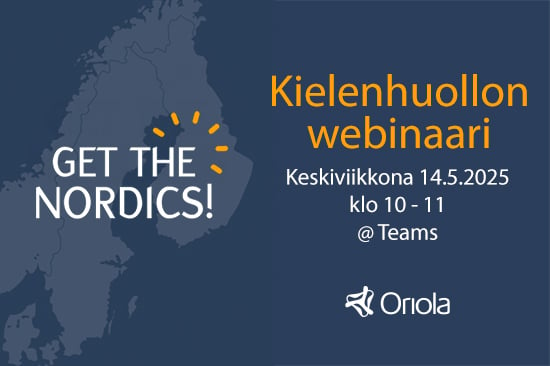Digitalisation will revolutionise healthcare
5.6.2017
Healthcare will undergo a major transformation in the next few years. Digitalisation will strengthen the role of the end user of healthcare services.
It was just a few years ago that electronic services were mainly used for booking appointments. Today we can get online diagnoses and health counselling. The change will require outside-the-box thinking by healthcare staff as the customer is now a cooperation partner in the care plan.
More transparency and measurability
The Government’s social welfare and healthcare reform in Finland relies heavily on digitalisation. Once the regional system has been implemented, all services will be provided to customers through one telephone number or chat serving the entire region. The person at the other end of the line will be a healthcare professional who decides what kind of care is needed and where it will be provided. It is estimated that 80% or 85% of customers will receive help with the first contact via telephone or a chat service.
The reform will also produce evaluation methods and indicators that will be used to evaluate customers with the same principles regardless of the home municipality. When the evaluation shows that a customer is entitled to receive home care, for example, he or she can choose the most suitable service provider available in the municipality within his or her health budget.
Digitalisation will also increase the transparency of healthcare services. There are innovations such as the eHospital service, created by Hämeenlinna-based Flowmedik Oy, that gathers user experiences and assessments on healthcare services. Reference data is collected from healthcare authorities, customers and healthcare professionals. The indicators used vary from customer and professional evaluations to numbers of patient injuries. eHospital will also publish the percentage of patients who get a doctor’s appointment within three days of seeking help.
All patient data in one place
A centralised repository will combine all patient data for the use of various care units nationwide. In public healthcare, prescriptions, diagnoses and laboratory results are already collected comprehensively in the patient data repository. Private healthcare service providers will soon be doing the same. 94 private companies are currently adding their information to the repository.
The tools used by healthcare professionals in electronic healthcare services include electronic patient records, data systems for laboratories and scanning, sharing of anamneses in the information network, electronic referrals and feedback as well as electronic prescriptions.
Patient data will be accessible from the repository regardless of the region where the customer needs help. The repository will also enable the use of earlier laboratory results, which will prevent overlapping tests.
My Kanta for Finnish residents
With the Patient Data Repository, people can examine their health records online. The service is available at www.kanta.fi. Furthermore, My Kanta contains all the electronic prescriptions which can also be renewed online.
My Kanta provides access to medical reports and laboratory and scanning results. There customers can also consent to or refuse the disclosure of personal data.
Everyone can also save their living wills and organ donation testaments in the service, but for the time being, this information will not be shared within the healthcare services. They will, however, be saved in the repository, where they can be printed when necessary.
Individual digital services
The innovative electronic service used in Hämeenlinna empowers the user. It is rapidly spreading to other regions in Finland. Minunterveyteni.fi (my health) is an electronic service offering individual assessment of symptoms and recommendations for further treatment.
When a customer feels ill, he or she will sign in to the service with a mobile ID or bank identifiers. The service will then make smart assessments on symptoms such as the following: pharyngeal and laryngeal symptoms, urinary tract inflammation symptoms, back problems, cough, anal symptoms and headaches.
The system will retrieve from the patient information system patient records, medication information, laboratory examinations and any data the patient has entered there. Then the system will combine all this data with reliable medical information administered by the Finnish Medical Society Duodecim.
The data collection is complemented with an electronic questionnaire that includes the same questions a nurse would ask. As a result, the system will give a recommendation for the next steps. The user will send the summary to a health centre where healthcare professionals and, if needed, a doctor will study it and the patient will quickly receive treatment.
The services also include remote monitoring of PEF, glucose and blood pressure. The customers will receive remote monitoring devices and the associated smart phone applications.
Teleconsultation
In summer 2016, the minunterveyteni.fi service launched a pilot project on teleconsultation to test various methods between patients and healthcare professionals and among healthcare professionals.
Teleconsultation as such has already been available for a few decades but it has been rather underused. Now that Kela’s reimbursements also cover mobile healthcare services, interest in teleconsultation has increased. The services today also include real-time chats between doctors and patients.
Customer experiences on remote monitoring have been collected in Hämeenlinna. Nearly 90% reported that the monitoring program was very user-friendly and they would recommend the system to others. Senior citizens have also been eager to provide help to others. The use of new technology often needs more than instructions and practical hands-on help is needed in everyday situations.
Artificial intelligence to revolutionise healthcare
Project Director Tuula Tiihonen from Sitra believes that individual services will form the core of healthcare. Artificial intelligence will provide computing capacity and the ability to target the customer with services necessary for his or her health.
The name of the project led by Tiihonen, Human-driven Health, supports her view. She is very familiar with the pilot project in Hämeenlinna and has actually participated in its development for three years.
“It’s an active service now, and spreading fast to other regions in Finland through the ODA project.”
ODA – Self Care and Digital Value Services – is the first Government key project in digitalisation that has received funding.
“In Hämeenlinna, it has been possible to increase the number of customer contacts with the health centre year on year, even though staff resources have remained the same.” Though the number of patient visits has decreased, the number of customer contacts has clearly increased. Customers receive better service but with new kinds of contacts.
Thanks to electronic self care, minor ailments can now be treated at home.
“This will save time for both customers and professionals and costs for society.” The nationwide implementation of the ODA services has been estimated to save 17 euros per citizen.
Five experimental areas in the freedom of choice have just been established in Finland. In these areas, private service providers can participate in the production of services in basic healthcare. According to Tiihonen, new start-up companies are particularly motivated to find out how to provide smarter and more agile services by using various partnership models.


